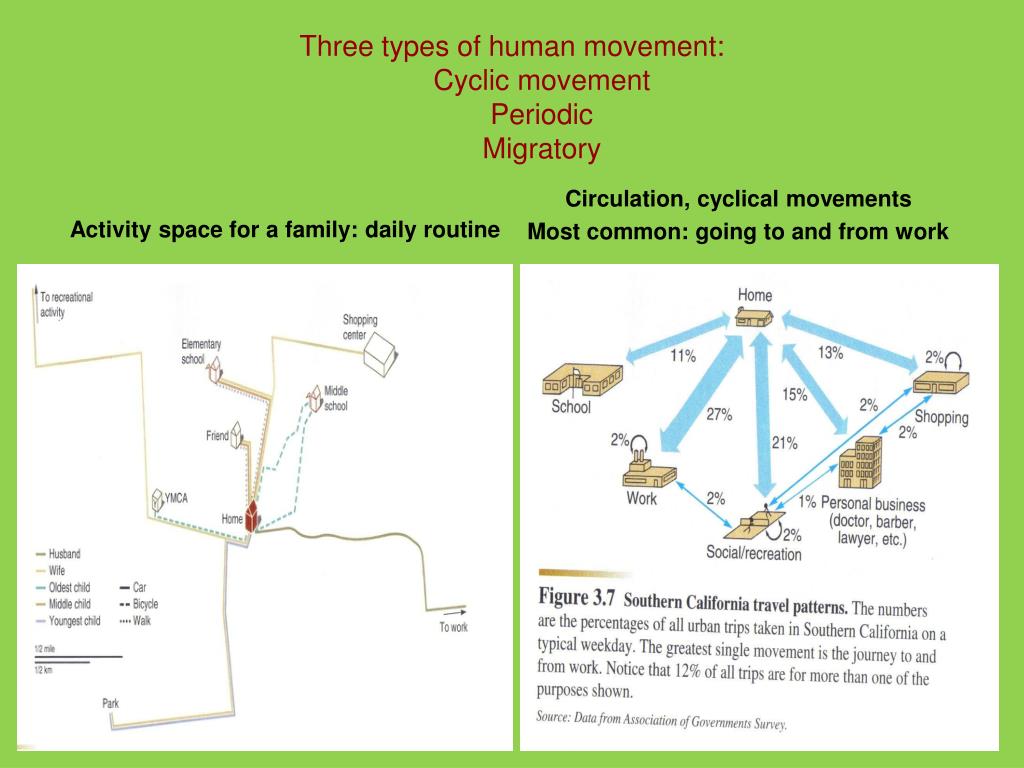Finally Understanding Cyclic Movement in AP Human Geography: A Comprehensive Guide
Are you wrestling with the concept of cyclic movement in AP Human Geography? Does the term conjure images of endless loops and leave you feeling lost? You’re not alone! Cyclic movement, a fundamental aspect of human geography, describes the short-term, repetitive, and often regular movement patterns people undertake. This guide will break down cyclic movement, exploring its various types, examples, and significance, helping you conquer this crucial topic.
What is Cyclic Movement? The Core Concept
Cyclic movement is the everyday movement that humans undertake on a regular basis. Think of it as the routine journeys that shape our daily lives. Unlike migration, which involves a permanent or semi-permanent relocation, cyclic movement is characterized by its:
- Short Duration: These movements happen relatively quickly, often within a day, week, or month.
- Repetitive Nature: They occur regularly, following a predictable pattern.
- Recurring Destinations: Individuals return to a home base or origin point.
Understanding cyclic movement is key to grasping how people interact with their environment, utilize space, and contribute to the overall organization of human settlements.
Types of Cyclic Movement: Exploring the Patterns
Let’s delve into the different types of cyclic movement, each with its own characteristics and implications:
Commuting: This is arguably the most common form of cyclic movement. It involves the daily travel between a person’s home and their workplace, school, or other regular destinations.
- Factors influencing commuting patterns:
- Job availability
- Transportation infrastructure
- Housing costs
- Urban planning and sprawl
- Factors influencing commuting patterns:
Seasonal Movement: This type reflects movement tied to specific seasons or times of the year.
- Examples:
- Snowbirds: Individuals who move to warmer climates during winter.
- Migrant farm workers: Who follow crop cycles.
- Tourists: Who travel to different locations for vacations.
- Examples:
Nomadism: Historically, nomadism was a more prevalent form of cyclic movement, involving regular movement within a defined territory, often in search of resources like grazing land or water. While less common today, remnants of nomadic practices persist in certain regions.
Activity Space: This refers to the area within which a person routinely moves during a day. It’s the sum of all the cyclic journeys a person takes. Activity space is often influenced by factors such as age, gender, socioeconomic status, and access to transportation.
Significance of Studying Cyclic Movement
Why is understanding cyclic movement important in AP Human Geography? It offers insights into:
- Urban Planning: Knowledge of commuting patterns helps urban planners design efficient transportation systems, manage traffic congestion, and create sustainable communities.
- Economic Development: Understanding seasonal movements, such as tourism, can inform economic strategies for specific regions.
- Social Interactions: Cyclic movement shapes social networks, cultural exchange, and the diffusion of ideas and innovations.
- Environmental Impacts: Commuting and other forms of cyclic movement contribute to pollution, resource consumption, and the overall impact on the environment.
- Accessibility and Inequality: Analyzing activity spaces reveals disparities in access to opportunities and resources based on factors like income, location, and disability.
Real-World Examples of Cyclic Movement in Action
Let’s look at some concrete examples:
- A city dweller commuting by train: This is a classic example of commuting. Every weekday, the person travels from their suburban home to their office in the city center and back.
- A farm worker migrating with the harvest: This illustrates seasonal movement. The worker follows the ripening of crops, moving from one region to another throughout the growing season.
- A tourist visiting a coastal resort: This exemplifies seasonal movement, driven by leisure and recreation. The tourist’s cyclic journey involves travel to and from the resort and the location of their permanent residence.
- A student going to school: This is a regular, daily commute that falls under cyclic movement.
Conclusion: Mastering the Cycles
Cyclic movement is a fundamental concept in AP Human Geography, providing a lens through which to understand the everyday patterns of human activity. By understanding the different types of cyclic movement, the factors that influence them, and their broader implications, you can gain a deeper appreciation for how humans interact with and shape the world around them. Remember to focus on the repetition, short duration, and recurring nature of these journeys, and you’ll be well on your way to mastering this important topic.
Frequently Asked Questions (FAQs)
- What’s the difference between cyclic movement and migration?
- Cyclic movement involves short-term, repetitive journeys, while migration involves a permanent or semi-permanent relocation to a new place.
- How can I identify cyclic movement in a real-world scenario?
- Look for patterns of travel that occur regularly, such as daily commutes, seasonal migrations, or weekly shopping trips.
- Why is understanding cyclic movement important for urban planning?
- It helps urban planners design efficient transportation systems, manage traffic, and create more sustainable and livable communities.
- What factors affect a person’s activity space?
- Age, gender, socioeconomic status, access to transportation, and personal preferences all play a role.
- Can cyclic movement have negative impacts?
- Yes, it can contribute to traffic congestion, pollution, and resource consumption, particularly in areas with high population density and reliance on private vehicles.




